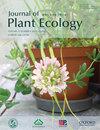草地植被调查中的观察者误差:对物种多样性指标和物种丰度关系的影响
IF 3.9
2区 环境科学与生态学
Q2 ECOLOGY
引用次数: 0
摘要
我们研究了观测者误差对四种常用的物种多样性指标的影响:物种丰富度、Shannon-Weiner多样性、Shannon-Veiner均匀度和Simpson多样性指数。我们还评估了观测者误差如何影响通过非度量多维尺度排序确定的物种-丰度关系的多元分析得出的推断。三位不同的植物学家在美国密苏里州和堪萨斯州的两个国家公园单位对草原植被进行了采样。两位植物学家对相同的地块进行了采样,他们编制了物种组成和估计的叶面覆盖率列表。然后比较数据记录中的差异。伪更替(即观察者误差引起的表观更替)范围为17.1%至22.1%,覆盖类别估计的差异范围为21.5%至30.5%。成对观察者之间物种多样性测量的百分比差异取决于数据的汇总方式,但总是<20%,通常<10%。基于这些结果,与营业额指数相比,物种多样性指标受到观察者误差的影响相对较小。然而,周转指数包含更多的信息,因为它们跟踪单个物种,而在大多数物种多样性指数中,物种是可互换的。因此,由于物种多样性指数的计算方式,识别出的误差较小。NMS排序显示,虽然不同观察者对某些图的描述相似,但观察者对其他图的记录之间的差异导致排序空间的分离度更大。与其他观察者相比,代表一个观察者记录的点在排序空间中经常向同一方向移动。本文章由计算机程序翻译,如有差异,请以英文原文为准。
Observer error in grassland vegetation surveys: Effects on species diversity metrics and species-abundance relationships
We investigated the effect of observer error on four commonly used species diversity measures: species richness, Shannon-Weiner diversity, Shannon-Weiner evenness, and Simpson's index of diversity. We also evaluated how observer error affects inferences derived from multivariate analyses of species-abundance relationships as determined by non-metric multidimensional scaling (NMS) ordination. Grassland vegetation was sampled by three different botanists at two national park units in Missouri and Kansas, USA. The same plots were sampled by two of the botanists, who compiled lists of species composition and estimated foliar cover. Differences in the data records were then compared. Pseudoturnover (i.e., apparent turnover due to observer error) ranged from 17.1 to 22.1%, and differences in cover class estimation ranged from 21.5 to 30.5%. The percentage difference in species diversity measures between pairs of observers depended on how data were summarized, but were always <20%, and often <10%. Based on these results, species diversity metrics are affected to a relatively smaller extent by observer error than turnover indices. Turnover indices, however, contain more information because they track individual species, whereas species are interchangeable in most species diversity indices. Thus less of the error is identified because of how species diversity indices are calculated. NMS ordinations revealed that while the characterizations of some plots by different observers were similar, differences between observers’ records for other plots resulted in greater separation in ordination space. Points representing one observer’s records were often shifted in ordination space in the same direction compared to the other observer.
求助全文
通过发布文献求助,成功后即可免费获取论文全文。
去求助
来源期刊

Journal of Plant Ecology
生物-植物科学
CiteScore
4.60
自引率
18.50%
发文量
134
审稿时长
3 months
期刊介绍:
Journal of Plant Ecology (JPE) serves as an important medium for ecologists to present research findings and discuss challenging issues in the broad field of plants and their interactions with biotic and abiotic environment. The JPE will cover all aspects of plant ecology, including plant ecophysiology, population ecology, community ecology, ecosystem ecology and landscape ecology as well as conservation ecology, evolutionary ecology, and theoretical ecology.
 求助内容:
求助内容: 应助结果提醒方式:
应助结果提醒方式:


